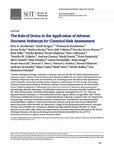The Role of Omics in the Application of Adverse Outcome Pathways for Chemical Risk Assessment.
| dc.contributor.author | Brockmeier, EK | en |
| dc.contributor.author | Hodges, G | en |
| dc.contributor.author | Hutchinson, TH | en |
| dc.contributor.author | Butler, E | en |
| dc.contributor.author | Hecker, M | en |
| dc.contributor.author | Tollefsen, KE | en |
| dc.contributor.author | Garcia-Reyero, N | en |
| dc.contributor.author | Kille, P | en |
| dc.contributor.author | Becker, D | en |
| dc.contributor.author | Chipman, K | en |
| dc.contributor.author | Colbourne, J | en |
| dc.contributor.author | Collette, TW | en |
| dc.contributor.author | Cossins, A | en |
| dc.contributor.author | Cronin, M | en |
| dc.contributor.author | Graystock, P | en |
| dc.contributor.author | Gutsell, S | en |
| dc.contributor.author | Knapen, D | en |
| dc.contributor.author | Katsiadaki, I | en |
| dc.contributor.author | Lange, A | en |
| dc.contributor.author | Marshall, S | en |
| dc.contributor.author | Owen, SF | en |
| dc.contributor.author | Perkins, EJ | en |
| dc.contributor.author | Plaistow, S | en |
| dc.contributor.author | Schroeder, A | en |
| dc.contributor.author | Taylor, D | en |
| dc.contributor.author | Viant, M | en |
| dc.contributor.author | Ankley, G | en |
| dc.contributor.author | Falciani, F | en |
| dc.date.accessioned | 2018-05-10T08:34:49Z | |
| dc.date.available | 2018-05-10T08:34:49Z | |
| dc.date.issued | 2017-08-01 | en |
| dc.identifier.uri | http://hdl.handle.net/10026.1/11478 | |
| dc.description.abstract |
In conjunction with the second International Environmental Omics Symposium (iEOS) conference, held at the University of Liverpool (United Kingdom) in September 2014, a workshop was held to bring together experts in toxicology and regulatory science from academia, government and industry. The purpose of the workshop was to review the specific roles that high-content omics datasets (eg, transcriptomics, metabolomics, lipidomics, and proteomics) can hold within the adverse outcome pathway (AOP) framework for supporting ecological and human health risk assessments. In light of the growing number of examples of the application of omics data in the context of ecological risk assessment, we considered how omics datasets might continue to support the AOP framework. In particular, the role of omics in identifying potential AOP molecular initiating events and providing supportive evidence of key events at different levels of biological organization and across taxonomic groups was discussed. Areas with potential for short and medium-term breakthroughs were also discussed, such as providing mechanistic evidence to support chemical read-across, providing weight of evidence information for mode of action assignment, understanding biological networks, and developing robust extrapolations of species-sensitivity. Key challenges that need to be addressed were considered, including the need for a cohesive approach towards experimental design, the lack of a mutually agreed framework to quantitatively link genes and pathways to key events, and the need for better interpretation of chemically induced changes at the molecular level. This article was developed to provide an overview of ecological risk assessment process and a perspective on how high content molecular-level datasets can support the future of assessment procedures through the AOP framework. | en |
| dc.format.extent | 252 - 262 | en |
| dc.language | eng | en |
| dc.language.iso | eng | en |
| dc.subject | in vitro and alternatives | en |
| dc.subject | methods | en |
| dc.subject | predictive toxicology | en |
| dc.subject | regulatory/policy | en |
| dc.subject | risk assessment | en |
| dc.subject | toxicogenomics | en |
| dc.subject | Adverse Outcome Pathways | en |
| dc.subject | Animals | en |
| dc.subject | Humans | en |
| dc.subject | Lipid Metabolism | en |
| dc.subject | Metabolomics | en |
| dc.subject | Proteomics | en |
| dc.subject | Risk Assessment | en |
| dc.subject | Transcriptome | en |
| dc.title | The Role of Omics in the Application of Adverse Outcome Pathways for Chemical Risk Assessment. | en |
| dc.type | Journal Article | |
| plymouth.author-url | https://www.ncbi.nlm.nih.gov/pubmed/28525648 | en |
| plymouth.issue | 2 | en |
| plymouth.volume | 158 | en |
| plymouth.publication-status | Published | en |
| plymouth.journal | Toxicol Sci | en |
| dc.identifier.doi | 10.1093/toxsci/kfx097 | en |
| plymouth.organisational-group | /Plymouth | |
| plymouth.organisational-group | /Plymouth/Research Groups | |
| plymouth.organisational-group | /Plymouth/Research Groups/BEACh | |
| plymouth.organisational-group | /Plymouth/Users by role | |
| dc.publisher.place | United States | en |
| dc.identifier.eissn | 1096-0929 | en |
| dc.rights.embargoperiod | No embargo | en |
| rioxxterms.versionofrecord | 10.1093/toxsci/kfx097 | en |
| rioxxterms.licenseref.uri | http://www.rioxx.net/licenses/all-rights-reserved | en |
| rioxxterms.type | Journal Article/Review | en |


